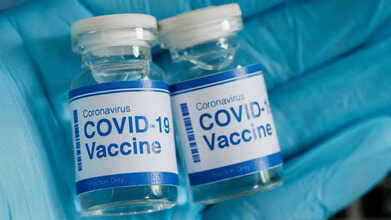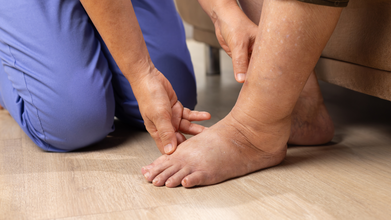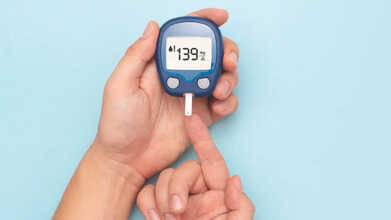- Health Conditions A-Z
- Health & Wellness
- Nutrition
- Fitness
- Health News
- Ayurveda
- Videos
- Medicine A-Z
- Parenting
- Web Stories
Lesser-Known Vitamin B12 Deficiency Symptom That Shows Up At Night: 4 Ways To Tackle It

(Credit-Canva)
Vitamin B12 deficiency is a problem that many people face in the world, however it is not highlighted as much. According to a 2019 study published in the Indian Journal of Endocrinology and Metabolism, the prevalence of vitamin B12 deficiency in tier 3 cities of India was 47.19%. While it may be common, not many people know important signs of it. One such sign that shows up at night is, night sweats.
Often missed or mistaken, a deficiency in vitamin B12 or vitamin B9 (folate) causes a type of anemia. This condition happens when your body produces red blood cells that are abnormally large and cannot work correctly.
There are many missed or overlooked signs of vitamin B12 deficiency, a few of which show up at night or when you are sleeping. According to a 2015 study published in the Electronic Journal of General Medicine in some patients, the main signs of this deficiency were very severe drenching night sweats and extreme fatigue.
Are Night Sweats A Sign of Vitamin B12 Deficiency?
According to the Scottish Medical Journal, vitamin B12 deficiency is a common problem that can affect your nervous system in many ways. Sometimes, it can cause problems with your body's automatic functions, like sweating.
The study dealt with three different cases where patients suffered from drenching night sweats (meaning they sweated heavily at night). Doctors believed the severe sweating was caused by their low vitamin B12 levels.
After all three patients were treated with vitamin B12 shots, their night sweats and other symptoms improved dramatically and quickly. This suggests that intense night sweats can be a sign of a vitamin B12 shortage.
Such cases were also noted in the 2015 study. A 57-year-old man was sent to a specialist because he had been struggling with severe night sweats for about three to four years. The sweating was so heavy that he had to change his bedsheets almost every night.
Based on a key finding of high homocysteine levels—a sign that the body might not be using Vitamin B12 correctly, even if the vitamin's blood level was fine—doctors decided to try B12 treatment.
He was given Vitamin B12 shots daily for one week, followed by monthly shots. The results were dramatic: the patient reported that his severe sweating started to clear up after just the second injection. Three months later, he was checked again and was completely symptom-free. The vitamin B12 injections fixed his long-standing sweating problem.
Other Signs of Vitamin B12 Deficiency
The symptoms of a vitamin B12 or folate deficiency can start slowly and get worse if not treated. While fatigue (feeling weak or tired) is common, the NHS highlights other important signs. According to the UK National Health Service (NHS), the symptoms of a vitamin B12 or folate deficiency can start slowly and get worse if not treated. While fatigue (feeling weak or tired) is common, other symptoms can feel like stress or anxiety, such as heart palpitations (a rapid or irregular heartbeat). The list of potential symptoms includes:
- Palpitations (fast, pounding heart)
- Rapid breathing or shortness of breath
- Headaches
- Indigestion or loss of appetite
- Diarrhoea
- A sore or red tongue, sometimes with mouth ulcers
- Problems with vision
- Cognitive changes (issues with memory, thinking, or judgment
A vitamin B12 deficiency can also cause symptoms that affect your nervous system (brain and nerves):
- Numbness or pins and needle
- Muscle weakness
- Psychological problems like mild depression, anxiety, confusion, or even dementia
- Problems with balance and coordination
- Incontinence (loss of bladder control)
What Foods Can Help You Tackle Vitamin B12 Deficiency?
To help prevent a deficiency, make sure you include these foods in your diet:
- Meat and fish
- Eggs
- Dairy products (milk, cheese, etc.)
- Specially fortified foods (like certain breakfast cereals)
Who Is Eligible For The COVID Vaccine Or Autumn Booster In The UK?

Credits: Canva
Who is eligible for covid shot 2025: This year, there has been a “significant change” in who can get the COVID vaccine, according to Community Pharmacy England (CPE). The updated eligibility rules have caused confusion among the public and, in some cases, led to abusive behaviour towards pharmacy staff. Pharmacy teams report that up to half of the patients booked through the NHS National Booking Service (NBS) aren’t eligible, while some ineligible individuals have been sent by their GPs. The National Pharmacy Association (NPA) describes the situation as “deeply frustrating” for both patients and pharmacists.
Who Is Eligible for the COVID Vaccine In the UK This Winter?
This winter, the NHS is offering the COVID vaccine to:
- People aged 75 and over
- Anyone aged six months to 74 with a weakened immune system
- Residents of care homes for older adults
Getting vaccinated this autumn helps protect against serious illness from COVID over the winter months.
How to Book the Vaccine?
Eligible individuals are encouraged to book via the NHS online booking service or the NHS app. People aged five and over who are eligible can also walk into a vaccination site without an appointment. Those who don’t meet the criteria can still get the vaccine privately.Flu Jab Eligibility
More people qualify for the flu jab, including:
- Those over 65
- People with long-term health conditions
- Pregnant women
- All primary school children
- Secondary school children in years 7–11
- Frontline healthcare workers
- Care home residents
- Certain carers or people living with someone with a weakened immune system
Why Are Some Booking Errors Happening?
Confusion has arisen because the online system allows patients to book COVID and flu vaccines at the same time. Henry Gregg, chief executive of the NPA, said:
“This situation should have been avoidable and is very frustrating for both pharmacies and patients. We ask that patients treat pharmacy staff with respect as they navigate the new NHS rules. We’ve raised the issue with NHS England and the Department of Health and hope for a quick resolution.”
What Is the Autumn Booster?
By autumn, protection from earlier COVID vaccines can start to wane. For those at higher risk of severe illness, the NHS provides a free autumn booster.
The current vaccines continue to provide strong protection against hospitalisation and serious disease. Data from UKHSA shows that people who received a booster last autumn were around 43% less likely to be admitted to hospital with COVID-19, starting two weeks after vaccination, compared to those who remained unvaccinated.
'1 In 3 Indians Has Fatty Liver' Gastroenterologist Reveals A Key Early Sign You Should Know

(Credit-Canva)
As lifestyle diseases like obesity, diabetes, and certain heart health issues rise, many people are worried about their declining health and how to fix it. Another such disease is fatty liver disease, also known as Non Alcoholic Fatty Liver Disease (NAFLD)
According to a 2021 study, out of an estimate from 2903 children and 23,581 adult participants, the overall estimated average of NAFLD was 38.6%.
Fatty liver disease happens when too much fat builds up in your liver. If we catch it early, this condition is usually not a big health risk and can often be cured easily.
However, if left untreated, it can cause a lot of problems. To tackle this and catch this disease early, one must learn how to identify the symptoms of fatty liver. To help with this, Dr. Pradip Vekariya, Gastroenterologist, posted a video on his social media handle. In the caption he wrote, “1 in 3 Indians has fatty liver — are you one of them? Fatty liver can silently progress to liver cirrhosis if ignored.” He then pointed out an early symptom that can help you get an early diagnosis and avoid the later consequences, which is Pedal edema (swollen feet).
Are Swollen Feet A Sign of Fatty Liver?
If you notice swelling in your feet and ankles—a condition doctors call pedal edema—it might be more than just tired legs. This swelling can often be an early sign that your liver is in trouble. This is a sign that soon things will become worse.
If the disease gets worse, the liver becomes inflamed and damaged. Over time, healthy liver tissue is replaced with scar tissue, which stops the liver from working properly. When this severe, permanent damage occurs, it's called liver cirrhosis. This is dangerous and can lead to liver failure or even liver cancer.
How Swelling Is A Sign Of Liver Damage
As fatty liver disease moves into the serious stage of liver cirrhosis, you often start to notice swelling in different parts of your body. This happens because the liver is no longer working properly. Here are some other body parts that also may be affected with swelling according to National Health Services UK.
Abdomen (Ascites)
One of the clearest signs of advanced liver disease is swelling in the belly, known as ascites. Because the pressure is so high, fluid leaks directly out of the blood vessels and collects inside the abdomen. This causes the belly to look swollen and feel uncomfortable.
Legs, Ankles, and Feet (Edema)
The increased pressure also pushes fluid out in other areas. This commonly causes swelling in the legs and ankles, which is called edema. Since gravity pulls the fluid down, the feet often swell too.
Hands and Arms
Fluid retention caused by liver problems and high pressure can also cause your hands to swell, making them look puffy and bloated.
Chest and Breasts (In Men)
In men, severe liver disease can upset the balance of hormones in the body. This hormonal change can lead to a condition called gynecomastia, which is when the breast tissue becomes enlarged. This issue may also be connected to a loss of sex drive and problems having children.
How To Manage Fatty Liver?
If you notice unexplained swelling in any of these areas, it is crucial to see a doctor immediately. While swelling can signal liver disease, it can also be caused by other serious conditions like heart or kidney failure. A doctor will perform tests (like blood work and imaging) to find the exact cause and get you the right treatment. It is very important to get an early diagnosis to prevent fatty liver disease from getting worse. The best way to manage it, especially in the early stages, is through lifestyle changes:
- Adopt a healthy diet.
- Exercise regularly.
- Avoid drinking alcohol.
Blood Sugar Level Reading: Simple Guide To Track High And Low Levels in Type 1 Diabetes

Credits: Canva
When someone is newly diagnosed with type 1 diabetes, one of the first questions they ask is: what should my blood sugar levels be? What counts as normal, high, or low? Blood sugar levels vary from person to person because each body is unique. Factors such as age, personal health history, food intake, medication, activity levels, and even stress can influence how your body processes glucose.
While health organizations provide general guidelines for people without diabetes, target blood sugar levels for someone with type 1 diabetes are individualized. Your healthcare provider will help set goals that fit your lifestyle, age, and overall health needs, making management safer and more effective.
What Is Blood Sugar?
When we eat, the carbohydrates in our food are broken down into glucose, the body’s primary energy source. Glucose enters the bloodstream, and the hormone insulin helps move it into cells, providing fuel for muscles and organs. When this process works well, your blood sugar remains in a healthy range, giving your body enough energy without leaving excess sugar circulating in the blood.
For people with type 1 diabetes, the body doesn’t produce enough insulin naturally, so glucose can build up in the bloodstream. This makes regular monitoring of blood sugar levels essential.
What Is a Normal Blood Sugar Reading for Type 1 Diabetes?
Health organizations like the American Diabetes Association (ADA) and the Centers for Disease Control and Prevention (CDC) provide guidance:
Before meals (fasting):
- 80–130 mg/dL (4.4–7.2 mmol/L) for teens and adults
- 100–180 mg/dL (5.5–10.0 mmol/L) for children 6–12 years
- 100–180 mg/dL (5.5–10.0 mmol/L) for children under 6
Two hours after a meal:
- Less than 180 mg/dL (10 mmol/L)
These ranges are general guidelines. Your healthcare provider may adjust your targets based on your age, other health conditions, pregnancy, or lifestyle. Understanding these numbers and how they respond to food, activity, and medication is key to staying healthy.
When and How Should I Check My Blood Glucose?
Most people with type 1 diabetes check their blood glucose multiple times a day to ensure their levels stay within their target range. How often you check depends on your treatment plan and daily routine.
Common methods include:
- Blood glucose meter: Measures glucose from a small finger-prick blood sample. This method is quick and widely used at home.
- Continuous Glucose Monitoring (CGM): A tiny sensor under the skin tracks glucose levels every few minutes, providing real-time readings throughout the day and night. CGM is especially useful for people on insulin or who have frequent low blood sugar episodes.
- A1C test: A lab test that measures your average blood glucose over the past three months. Most people with diabetes take this test at least twice a year, but your provider may recommend it more often if you are not meeting your treatment goals.
Tips for Tracking Blood Sugar
- Keep a log: Note your blood sugar readings, meal times, and physical activity to spot patterns.
- Check before and after meals: This helps understand how different foods affect your glucose.
- Monitor trends: Don’t focus only on single readings—look at patterns over days or weeks.
- Work closely with your healthcare team: They can help adjust insulin doses or other treatments based on your tracking.
Regular monitoring and understanding your numbers can help prevent complications, manage symptoms, and improve your quality of life. Tracking blood sugar is not just about numbers, it’s about learning how your body responds and making informed choices every day.
© 2024 Bennett, Coleman & Company Limited

